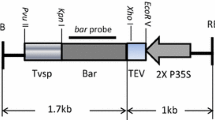Abstract
A number of factors that are known to influence genetic transformation were evaluated to optimizeAgrobacterium-mediated transformation of hypocotyl explants of cauliflower variety Pusa Snowball K-1. The binary vector p35SGUSINT mobilized intoAgrobacterium strain GV2260 was used for transformation and transient GUS expression was used as the basis for identifying the most appropriate conditions for transformation. Explant age, preculture period, bacterial strain and density were found to be critical determinants of transformation efficiency. Using the optimized protocol, the syntheticcryIA(b) gene was mobilized into cauliflower. Molecular analyses of transgenics established the integration and expression of the transgene. Insect bioassays indicated the effectiveness of the transgene against infestation by diamondback moth (Plutella xylostella) larvae.
Similar content being viewed by others
References
Ausubel F M, Brent R, Kingston R E, Moore D D, Seidman J G, Smith J A and Struhl K 1994Current protocols in molecular biology (New York: John Wiley)
Berthomieu P, Beclin C, Charlot F, Dore C and Jouanin L 1994 Routine transformation of rapid cycling cabbage (Brassicaoleracea) — molecular evidence for regeneration of chimeras;Plant Sci. 96 223–235
Bhalla P L and Smith N 1998Agrobacterium tumefaciens-mediated transformation of cauliflower,Brassica oleracea var.botrytis;Mol. Breed 4 531–541
Cheng X Y, Sardana R, Kaplan H and Altosaar I 1998Agrobacterium-transformed rice plants expressing syntheticcryIA(b) andcryIA(c) genes are highly toxic to striped stem borer and yellow stem borer;Proc. Natl. Acad. Sci. USA 95 2767–2772
Chilton M D, Currier T, Farrand S, Bendich A, Gordon M P and Nester E W 1974Agrobacterium tumefaciens DNA and PS8 bacteriophage DNA not deleted in crown gall tumors;Proc. Natl. Acad. Sci. USA 71 3672–3676
Chomcznski P and Sacchi N 1987 Single-step method of RNA isolation by acid guanidinium thiocyanate-phenol-chloroform extraction;Annal. Biochem. 162 156–159
Church G M and Gilbert W 1984 Genomic Sequencing;Proc. Natl. Acad. Sci. USA 81 1991–1995
Ding L C, Hu C Y, Yeh K W and Wang P J 1998 Development of insect resistant transgenic cauliflower plants expressing the trypsin inhibitor gene isolated from local sweet potato;Plant Cell Rep. 17 854–860
Doyle J J and Doyle J L 1990 Isolation of plant DNA from fresh tissues;Focus 12 13–15
Estruch J J, Carozzi N B, Desai N, Duck N B, Warren G W and Koziel M G 1997 Transgenic plant: An emerging approach to pest control;Nat. Biotech. 15 137–141
Fujimoto H, Itoh K, Yamamoto M, Kyozuka J and Shimamoto K 1993 Insect resistant rice generated by introduction of a modified δ-endotoxin geneBacillus thuriengiensis;Bio/ Technology 11 1151–1155
Henzi M X, Christey M L and McNeil D L 2000 Factors that influenceAgrobacterium rhizogenes mediated transformation of broccoli (Brassica oleracea L. var.italica);Plant Cell Rep. 19 994–999
Hofgen R and Willmitzer Z 1990 Biochemical and genetic analysis of different potatin isoforms expressed in various organs of potato (Solanum tubersoum);Plant Sci. 66 221–230
Jefferson R A 1987 Assaying chimeric genes in plants: the GUS gene fusion system;Plant Mol. Biol. Rep. 5 387–405
Metz T D, Dixit R and Earle E D 1995Agrobacterium tumefaciens mediated transformation of broccoli (Brassica oleracea var.italica) and cabbage (B. oleracea var.capatita);Plant Cell Rep. 15 287–292
Mukhopadhyay A, Topfer R, Pradhan A K, Sodhi Y S, Steinbi H-H, Schell J and Pental D 1991 Efficient regeneration ofBrassica oleracea hypocotyl protoplasts and high efficiency genetic transformation by direct DNA uptake;Plant Cell Rep. 10 375–379
Murashige T and Skoog F 1962 A revised medium for rapid growth and bioassays with tobacco tissue culture;Physiol. Plant. 15 473–497
Ovesna J, Ptacek L and Opatrny Z 1993 Factors influencing the regeneration capacity of oilseed rape and cauliflower in transformation experiments;Biol. Plant. 35 107–112
Palmgren G, Mattson O and Okkels F T 1993 Treatment ofAgrobacterium or leaf discs with 5-azacytidine increases transgene expression in tobacco;Plant Mol. Biol. 21 429–435
Passelgue E and Kerlan C 1996 Transformation of cauliflower (Brassica oleracea var.botrytis) by transfer of cauliflower mosaic gene through cocultivation with virulent and avirulent strainsof Agrobacterium;Plant Sci. 113 79–89
Pius P K and Achar P N 2000 Genetic transformation and hybridization:Agrobacterium-mediated transformation and plant regeneration ofBrassica oleracea var.capitata;Plant Cell Rep. 19 888–892
Puddephat J, Riggs T J and Fenning T M 1996 Transformation ofBrassica oleracea L.: a critical review;Mol. Breed. 2 185–210
Sangwan R S, Bourgeois Y, Brown S, Vasseur G and Sangwan-Norreel B 1992 Characterization of competent cells and early events ofAgrobacterium-mediated genetic transformation inArabidopsis thaliana;Planta 188 439–456
Shimoda N, Toyoda-Yamamoto A, Nagamine J, Usami S, Katayama M, Sakagami Y and Machida Y 1990 Control of expression ofAgrobacterium vir genes by synergistic action of phenolic signal molecules and monosaccharides;Proc. Natl. Acad. Sci. USA 87 6684–6688
Srivastava V, Reddy A S and Mukherjee S G 1988 Transformation and regeneration ofBrassica oleracea mediated by an oncogenicAgrobacterium tumefaciens;Plant Cell Rep. 7 504–507
Tabashnik B E 1997 Seeking the root of insect resistance to transgenic plants;Proc. Natl. Acad. Sci. USA 94 3488–3490
VanWordragen M G and Dons H J M 1992Agrobacterium tumefaciens-mediated transformation of recalcitrant crops;Plant Mol. Biol. Rep. 10 12–36
Vancanneyt G, Schmidt R, O’Conner-Sanchez A, Willmitzer L and Rocha-Sosa M 1990 Construction of an introncontaining marker gene: splicing of the intron in transgenic plants and its use in monitoring early events inAgrobacterium-mediated plant transformation;Mol. Gen. Genet. 220 245–250
Xiang Y, Wong W K R, Ma M C and Wong R S C 2000Agrobacterium mediated transformation ofBrassica campestris ssp.parachinensis with syntheticBacillus thuringiensis cry-IAb andcryIAc genes;Plant Cell Rep. 19 251–256
Author information
Authors and Affiliations
Corresponding author
Rights and permissions
About this article
Cite this article
Chakrabarty, R., Viswakarma, N., Bhat, S.R. et al. Agrobacterium-mediated transformation of cauliflower: Optimization of protocol and development of Bt-transgenic cauliflower. J. Biosci. 27, 495–502 (2002). https://doi.org/10.1007/BF02705046
Received:
Accepted:
Published:
Issue Date:
DOI: https://doi.org/10.1007/BF02705046




